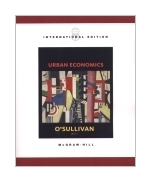|

URBAN ECONOMICS.
O'SULLIVAN wydawnictwo: MCGRW-HILL , rok wydania 2003, wydanie V cena netto: 250.00 Twoja cena 237,50 zł + 5% vat - dodaj do koszyka Urban Economics
Throughout the book, Arthur
O'Sullivan uses simple economic analysis to explain why cities exist, where they develop,
how they grow, and how different activities are arranged within cities. The author also
explores the economics of urban problems and policies related to poverty, housing,
transportation, education, and crime. O'Sullivan has updated added to the material on
theory, empirics, and policy discussion as well as streamlined the discussion throughout.
New to This Edition
- New
Chapter: "Big and Small Cities": This chapter explains the market forces that generate
large cities, exploring the most recent theoretical and empirical work on external
economies of scale in production. The chapter also explains why cities differ in size and
scope.
- New
Chapter: "Household Sorting": Most urban problems-poverty, crime, and weak education
are highly concentrated in a small number of neighborhoods, in part because households
sort themselves with respect to income, education level, and race. This new chapter on
household sorting explains the forces behind the sorting of households with respect to
income, race, and educational attainment. Sorting happens because: a. households
have different demands for local public goods, b. local public goods are supported by the
property tax, c. educational achievement depends on the student's peer group, and d.
some households have racial preferences.
- Problem
& Policy Chapters Rewritten: The chapters covering urban problems and policy follow
the new chapter on sorting, and have been rewritten thoroughly to focus attention on the
highly concentrated nature of urban poverty, crime, and weak education.
- Presentation
Streamlined: In order to get students to the most important topics in the course more
quickly, the author has streamlined the presentation throughout the book. Material has
been updated and revised to shorten the text to twenty chapters instead of twenty-two in
the 4th Edition.
- New
Section in Chapter 1, "The Role of Cities in the Economy": This new section explains
why cities are the centers of creativity and innovation, why cities promote learning among
workers, and why cities generate consumption benefits.
- Limits
to Growth Material Added: Chapter 2 now discusses the limits to growth-i.e., rising
commuting distances. In light of recent phenomena such as the flight from San Francisco,
this new coverage helps keep the book current.
- Analysis
of Market Interactions More Accessible: The last part of Chapter 8 explains the
interactions between the urban labor market and the urban land markets, using the
streetcar to illustrate the market interactions. This presentation is an alternative to
the more complex general-equilibrium analysis in the previous edition. In later chapters,
we use this framework to discuss the effects of various policies (an urban service
boundary and congestion taxes) on both the labor market and the land market.
Features
- All the tables and charts
continue to contain the most recent data. Insights and facts from current theoretical and
empirical research have been added in every chapter.
- The policy analysis
reflects recent changes in public policy and refinements in the economic analysis of
policy alternatives.
- URBAN ECONOMICS brings
urban issues into a modern microeconomic framework. This framework appeals to many micro
instructors because it closely matches their training and the way they want to teach the
course.
- Timely, well-presented, and
thorough applications are found throughout.
- This comprehensive text
allows instructors the flexibility to teach different kinds of urban courses. The author
provides several different course organizations in the preface to accommodate a variety of
urban interest courses.
- A "Tools of
Microeconomics" appendix covers essential topics from intermediate microeconomics. This
helps the student who has only had exposure to micro at the introductory level.
Table of Contents
- 1
Introduction
Part
I Market Forces in the Development of Cities
- 2
Why Do Cities Exist?
- 3
Big and Small Cities
- 4
Where Do Firms Locate?
- 5
Urban Growth
- 6
Market Areas and Central Place Theory
Part II Land Rent and Land
Use Patterns
- 7
Introduction to Land Rent
- 8
Land Use in a Monocentric City
- 9
Land Use in Modern Cities
- 10
Land Use Controls and Zoning
Part III Urban Transportation
- 11
Autos and Highways
- 12
Mass Transit
Part IV Urban Problems
- 13
Household Sorting
- 14
Urban Poverty
- 15
The Urban Education Problem
- 16
Urban Crime
Part V Housing
- 17
Why is Housing Different?
- 18
Housing Policies
Part VI Local Government
- 19
Local Government Spending
- 20
Local Government Revenue
Appendix Tool of
Microeconomics
Index
596 pages
Księgarnia nie działa. Nie odpowiadamy na pytania i nie realizujemy zamówien. Do odwolania !.
|


